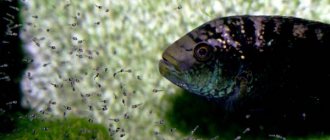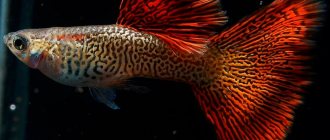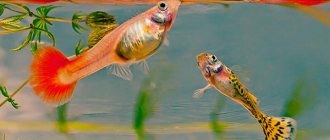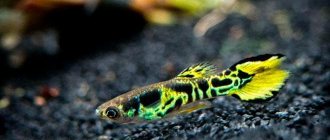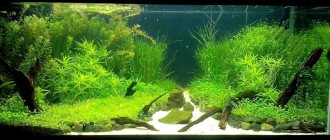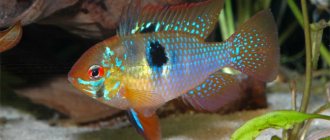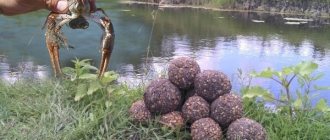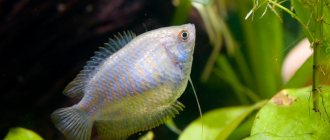Guppy
Author of the article: Olya Stvolova
Baby guppies are unique fish that are born from their mother’s womb, fully formed and ready for independent life! Therefore, it is not difficult to care for them, and it is always interesting to watch. Right before your eyes, a beautiful adult fish grows from a 3-5 mm fry. Due to the fact that guppies are guilty of cannibalism, the mother should be separated from the offspring immediately after birth.
14:43
GUPPY GIVING GIVING!Spawning live-bearing fish
Mother guppies eat their fry at the first opportunity, often without even waiting for the end of labor, provided that the baby itself swims to a critically close distance. After all, giving birth and hunting at the same time is quite problematic!
Guppy fry in a community aquarium
The survival rate of fry of any breed in a community aquarium is usually very low. Many of them die in the first hours after birth. What does this mean:
- A large number of natural enemies, including adult representatives of the same species, incl. parents;
- A small number of plants and small shelters;
- Lack of food because adult fish often eat everything clean;
- High population density in the aquarium;
- Aquarium equipment – filters and compressors. These life-saving devices often suck in, kill and/or maim small fish;
- Inadequate water quality. The immunity of fry is much weaker than that of their adult relatives, so what is normal for adult fish can cause illness and death for babies.
Thus, if you are pursuing the goal of preserving the offspring, but were unable to place the female in time, it is better to try to catch the fry from the general aquarium, rather than letting their survival take its course. If you don’t have such a goal , you can see the process of natural selection in action with your own eyes! The smartest and fastest will survive, but you shouldn’t expect outstanding external data from the survivors!
Small fish need as many shelters as possible, incl. plants.
With uncontrolled reproduction in a community aquarium, a common occurrence is degeneration of the breed. The appearance of the fish deteriorates generation after generation. Breed characteristics disappear. Therefore, we recommend buying new producers and fresh blood from time to time.
If you want to try to save the fry in a community aquarium, then you will need to replace the water twice a week, in a volume of at least 1/3 of the total volume. Carefully monitor the functioning of the systems, because during growing up all external factors are of great importance: lighting, temperature, filtration and aeration. In addition, the fish will have to be fed 3 times a day, with slightly larger portions of the fine fraction. If possible, you should increase the number of natural shelters - small-leaved plants, in which the fry can easily get lost.
How to save fry
It is recommended to keep guppy fry separately from adults, since their lives are in danger from the moment they appear - even during the birth process, they can be eaten by their own mother if the baby swims too close to her mouth.
You can, of course, leave the fry in a community aquarium, but then you need to place dense vegetation in it, in which you can hide. If you decide to keep the babies separately, then you need to remove the mother from the spawning tank in time. This is done immediately after the last baby is born.
If the birth has already begun in a community aquarium, you want to preserve the young, but there is no suitable shelter, then you can carefully catch the fry using a plastic cup and move them to a separate container. It will not be possible to save all the offspring, but some will definitely survive.
Caring for guppy fry
Caring for fry is simple, you just need to remember simple points:
- Well equipped aquarium;
- Quality food;
- Maintain the water in the required parameters and do not change them suddenly.
Let's take a closer look at each of them.
Aquarium equipment
The minimum package of equipment for raising guppy fry is a filter and compressor, a lamp and a heater, a thermometer. It is more convenient to use 2-in-1 devices. The filter must be turned on to minimum settings and a fine sponge must be used. An incandescent lamp, with constant supervision and monitoring of the temperature, will replace the heater. However, such lighting can provoke the growth of algae.
Water parameters
The water parameters for fry and adults do not differ critically, but they are worth comparing.
The fry require the following environmental parameters:
| Volume of water (in liters per 1 fry) | Temperature (°C) | Acidity (pH) | Hardness (mol/m³) |
| 0,5 | 26 — 28 | 7 | 10 -20 |
Adult guppies prefer:
| Volume of water per individual | Temperature (°C) | Acidity (pH) | Hardness (mol/m³) |
| 2.5 liters | 22-26 | 6,5-7,8 | 10-25 |
For favorable survival of babies in the same aquarium with adult fish, you need to choose average indicators that are suitable for both the former and the latter.
Guppy nutritional features
Small guppies need to be fed differently than adult guppies. If the big ones are fed twice a day, then the little ones 5 to 6 times. They give enough food at one time so that they can eat it right away. Otherwise, it will settle to the bottom and create life-threatening conditions for the fry in the aquarium: a lot of nitrogen will form , which will lead to the death of the guppy offspring. In addition, water changes should be done daily. It should be taken only from the aquarium where mom and dad swim.
There is no need to say that feeding is an extremely difficult issue, since the fry are ready to eat the food that is also fed to adults. The only question is the size of this food: it should be much smaller, since the mouths of guppy fry are very small. If you feed it dry food, you need to knead it between your fingers so that it turns into dust.
You can choose another option: purchase special food (Tetra MicroMin or Sera Micropan) intended for feeding fry. Both foods are balanced, so you don’t have to add anything: your fry will receive complete nutrition in accordance with their age.
Interesting: What to feed and how to properly keep crayfish in an aquarium
There is also a substitute MicroMin , which contains all the vitamins that baby guppies need in the first days of life.
In order for the fry to grow up to full size, they need to be fed carefully. You need to be especially careful about them in the first week. In addition, the light cannot be turned off even for a minute, otherwise the fry may die.
Fry from the hatchery
Baby guppies born in a separate container, upon reaching 1.5 centimeters in height, can be moved to an adult aquarium. Now they are large fish and nothing threatens them (or almost nothing). As for the age required for relocation, each fish, like any other child, develops at its own pace. Therefore, some will move to an adult jar at the age of 1 month, while others may stay in kindergarten until 3! Some of the brood become colored, reaching 1 cm, while others still have an unattractive, wild appearance for a long time.
Before moving:
- Provide as many hiding places as possible in an adult aquarium;
- Reduce the speed of the filter, it can still cause damage to small fish, although it is no longer fatal.
- Accustom the fry to water from an adult aquarium. To do this, add water from an adult aquarium to their aquarium for 2-3 days and equalize the temperature in the two containers, if this has not been done before.
For guppy fry, a fish tank attached to an adult aquarium is perfect. With its help you can easily solve the problem of moving.
Conditions of detention
The young guppy will feel much better and safer in a special nursery, where it will not be threatened by its adult relatives. To create all the conditions for children, it is necessary:
- Choose a container with a volume of approximately 25-50 liters - depending on the number of fry. The larger the volume, the easier it will be to care for.
- We take water from the community aquarium where the fish were born. There is no need to place soil, plants and shelters in the nursery. You need to change 30-40% of the water daily. The replacement liquid is left to stand for 3 days.
- A compressor, filter and heater are installed in the container. The aquarium is lit with a fluorescent lamp, as it hardly heats the water. The first three days of life, the temperature in the aquarium should be 27 ° C, then it is reduced first to 25, and by 4 months - to 24.
- The bottom siphons after changing the water. Filtration and aeration must be carried out constantly. The filter sponge is washed every week.
- The number of daylight hours should be gradually reduced. If in the first weeks of life the lamp should shine for 12 hours, then by 4 months this time is reduced to 8.
Feeding
During the first time after birth, the so-called newborn period, the fry still feed on the contents of the yolk sac, but this is only enough for a couple of hours, which means you need to start feeding the guppy fry from the first hours after birth.
During this period and until the fry reach the age of 7 days, their diet primarily consists of live dust, microworms and boiled chicken egg yolk crushed into dust.
You can purchase live dust at a pet store or from breeders, or dilute it yourself.
Feeding during this period is carried out 5-7 times a day at approximately equal intervals. It is very important that the daylight hours of the guppy fry at this time should not be less than 20 hours!
Feeding fry that have reached the age of one week is greatly simplified.
Fry from 7 to 50 days are already less whimsical in food and happily absorb any food that fits into their small mouths. Dry food mixtures, which can be easily purchased at any pet store, are well suited for teenagers. However, on high-quality live food, babies grow noticeably faster and quickly acquire their characteristic bright colors. During this period, it is good to give the fry: Artemia nauplii, crushed tubifex and bloodworms. It is now enough to feed them 3 times a day, and gradually reduce daylight hours to the standard 10 - 12 hours.
Upon reaching 60 days of age, guppy fry are considered conditionally adults and their feeding regime should coincide with the feeding of fish in a general aquarium.
How do guppies grow?
We have already mentioned the uneven growth of offspring from the same litter. However, the average growth parameters are:
- 1 day 2 – 5 mm.,
- 1 week 7 – 10 mm.,
- 1 month 10 – 20 mm.
Baby guppies grow quickly, but not evenly!
Guppies reach sexual maturity at the age of 2-4 months. And the first signs of sexual differences, the anal spot of females, become noticeable at 15 days of age . If you intend to select females and males, you need to resettle them immediately after the first sexual differences are discovered. After all, early-maturing fish can start mating without waiting for 2 months of age, this happens and is not considered uncommon!
Do not keep young males and females in the same jar, this will lead to uncontrolled inbreeding and degeneration!
Potential Difficulties
Difficulties await aquarium owners everywhere, even such a simple process as breeding viviparous guppies and raising their young can result in unexpected troubles...
- Beautiful and diverse selective forms are often unable to produce offspring, produce few fry, or their offspring do not copy the appearance of their parents.
- Poor quality care leads to diseases, sticky tail, spinal deformation, loss of aesthetic appearance and other troubles.
- Too many fish in an aquarium can also cause disease. Therefore, think in advance about how many fry you will keep for yourself, and for the rest you need to decide the fate in advance.
05:06
WHY DO GUPPIES DIE?
What to do with guppy fry
One of the most important questions that sooner or later faces a guppy breeder is what to do with the fry? There are several options for solving this:
- Beautiful and healthy fry will replenish the colony of your guppies in a community aquarium.
- Guppy fry are selected based on their external characteristics for further breeding and selection. In this case, females and males are kept separately.
- No matter how cruel it may sound, this is how nature created them. Guppies and other aquarium inhabitants will happily feast on the fry, just like any other live food. Only in the freshness and quality of newborn fish can you be 100% sure!
- Individuals that have reached a size of 1.5 - 2 cm can be handed over to a pet store or sold at a bird market or specialized sites (Yula, Avito, etc.) Be prepared for the fact that outbred nobles will not be sold for more than 10 - 15 rubles. But the cost of beautiful purebred males can reach several hundred.
Good luck with breeding and growing, Fish in a Jar!
How to prepare live food substitutes?
- Curdled milk . Fill this product with boiling water. Casein will curdle. The resulting clot is caught with a net with small cells. The contents are thoroughly washed to remove the whey. Small guppies need to be fed from a net. When shaken, a cloud of tiny food particles forms on the surface. The water in the aquarium does not spoil. Complementary foods are stored in the refrigerator.
- A hard-boiled chicken egg . The yolk is taken out and ground in a spoon. Water must be taken from the aquarium. Instead of a spoon, you can use gauze. The wrapped yolk flops around in the water. The fry eat the resulting egg dust. It should be noted that water from such complementary foods deteriorates quickly and will have to be changed more often.
- You can also feed small guppies with omelette . To do this, use a couple of eggs, to which 2 teaspoons of nettle are added. It is dried and thoroughly rubbed. You can add rolled oats. Pour into one hundred milliliters of boiling milk. The resulting mass is whipped. After cooling, you can offer it to the fry. Leftovers can be stored in the refrigerator. Storage time is limited.
- Fry living in an aquarium can be fed with powdered milk . It contains a lot of healthy protein. Regular milk should be evaporated in a water bath. The resulting powder is not able to dissolve in water. Therefore, within a few hours the fish eat it up without a trace.
- Guppies love cheese . Choose something that is not spicy. It should be grated using a grater with the smallest mesh. If the cheese is processed, then it must be dried. You don't need to add much, just for one time. Excesses can have a detrimental effect on water quality.
Interesting: Aquarium fish catfish synodontis
It is advisable not to feed the fry dry food during the first month. The fact is that you will not be able to pour it in as required. Excess food “rots”, forming a film on the water area of the aquarium. It does not allow air to pass through. In addition, small guppies cannot swallow such rough food.
